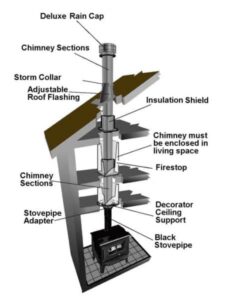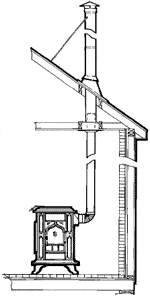 Before installing your wood stove read this helpful article on Chimney Location. A chimney is a long-term investment so it pays to get the right chimney installed properly. It is easy to make mistakes in selecting and locating a chimney, so here is some reliable advice that will help you avoid problems and get maximum performance from your chimney and wood burning appliance.
Before installing your wood stove read this helpful article on Chimney Location. A chimney is a long-term investment so it pays to get the right chimney installed properly. It is easy to make mistakes in selecting and locating a chimney, so here is some reliable advice that will help you avoid problems and get maximum performance from your chimney and wood burning appliance.
- Match the chimney to your stove or fireplace
- Put the chimney inside the house
- Locate the hearth in the heart of your home
- Your new chimney must meet safety codes
- Give the chimney some of the heat
- Maintain your chimney investment
Match the chimney to your stove or fireplace
To work properly, your new wood burning appliance needs a chimney that suits its characteristics. There are two main factors to match:
Size
In general, the chimney flue (the hole that gases flow through) should match the size of the outlet on the stove. Bigger is definitely not better when it comes to chimneys. In special cases (like with a very tall chimney), a chimney flue can be smaller than the appliance outlet. Always get professional advice before selecting a chimney of a different size than the stove outlet.
Insulation
High performance stoves and fireplaces need high performance chimneys. And high performance chimneys always have insulation. If you have selected a purely decorative fireplace without gasketed doors and air controls, then an uninsulated chimney like conventional masonry or air cooled metal might be satisfactory. But if you have an advanced stove or fireplace, you’ll need a high performance chimney like a 650°C model, a specialized fireplace chimney or a lining system in a masonry chimney.
Put the chimney inside the house
By far the biggest mistake you can make in buying a new chimney is to have it installed up the outside of your house. Outside chimneys allow leakage of cold air and odors into the house when  there is no fire burning in the stove, and can lead to smoking when a fire burns. Here is why.
there is no fire burning in the stove, and can lead to smoking when a fire burns. Here is why.
When it is cold outside, the warm air in the house wants to rise, just like hot exhaust rises in a chimney — this is called stack effect. Stack effect creates a slight low pressure area in the lower part of the house and a slight high pressure at the higher levels of the house. A neutral pressure plane (NPP) lies between the high and low pressure zones. If there is no fire in the stove or fireplace and the air in an outside chimney cools to below room temperature, the house becomes a better chimney than the chimney, and sucks cold, smelly air down the flue.
A chimney installed inside the house envelope is not affected by the negative pressure low in the house due to stack effect because an inside chimney is always at or above the house temperature. The neutral pressure plane always moves towards the big leaks, so the large opening at the chimney top means that the chimney has an NPP that is higher than the one in the house. The result is a gentle upward trickle of air through an inside chimney when no fire burns in the appliance.
If a chimney is kept warm by being inside the house, it will always make more standby draft than the house makes stack effect. The resulting low pressure zone at the fireplace opening means that when you light a fire it will kindle quickly without smoking.
Save yourself a lot of grief: don’t fall into the outside chimney trap.
Locate the hearth in the heart of your home
This is more than a hackneyed homage to homespun values, it is one key to a successful stove or fireplace. By locating your hearth inside the house and not against an outside wall, the chimney will rise through the warm space for most of its length and will exit the roof near its peak. The result is excellent chimney performance, unaffected by cold temperatures or harsh winds. Don’t make the mistake of locating a chimney low on the eaves of a cathedral roof, or in a one story section of a two story house. If the chimney exits the warm part of the house below its highest level, the house might function as a better chimney than the chimney.
Give the chimney some of the heat
You might think that any heat flowing into the chimney with the exhaust is waste, but it is not. The chimney needs heat to stay clean and free from corrosive moisture. Don’t be afraid to burn the stove or fireplace hot, at least for a brief period, each time you start a fire. This practice heats up the appliance and chimney structure and `primes’ the chimney to make reliable draft for the rest of the heating cycle.
Maintain your chimney investment
Chimneys must withstand corrosive compounds, extremes of temperature and repeated heating and cooling cycles. Each time a chimney heats up, its materials expand and when it cools they shrink. This constant movement takes its toll on joints, seals and the structural materials. There is also the potential for the build up of combustible deposits called creosote. To protect your investment, check the chimney for creosote regularly and have it professionally cleaned and inspected annually (fire codes require chimneys to be inspected and cleaned at least once a year). By following this advice, your investment will be protected through preventative maintenance before serious damage occurs.\
Call the Barrie Home Inspection Service for all your Wood Burning Inspection Requirements. Providing inspection services to all of Simcoe County.
